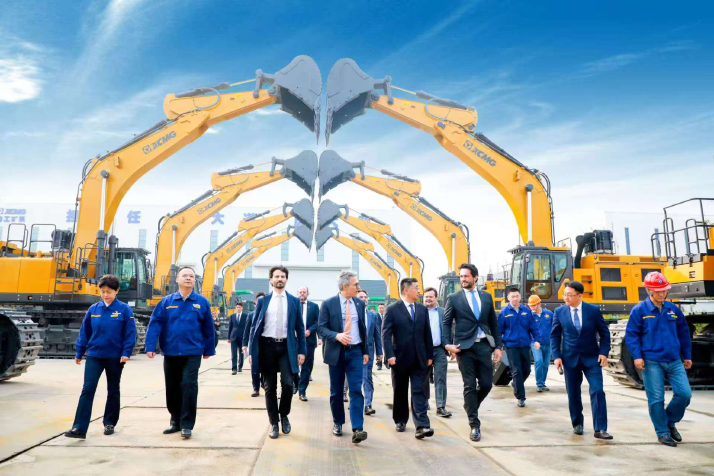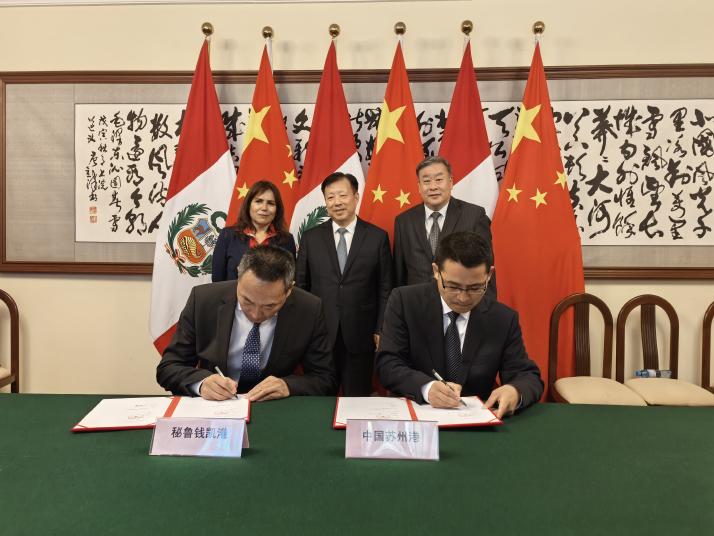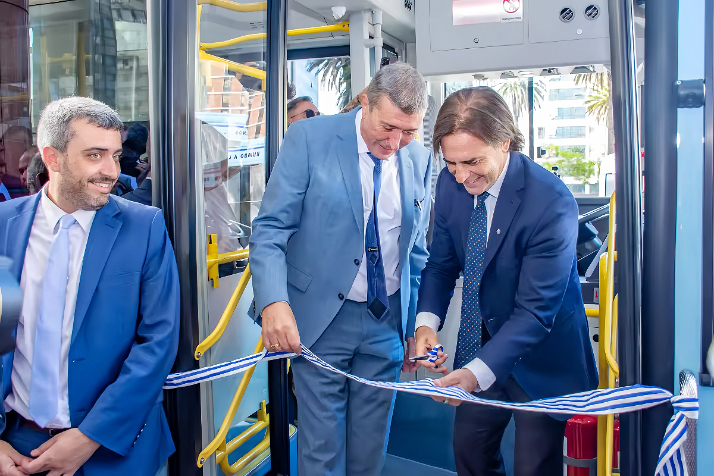| World |
| Jiangsu Province deepens collaboration with Latin America and the Caribbean | |
|
|
 A delegation from Minas Gerais State, Brazil, led by Governor Romeu Zema (fourth left), visits Xuzhou Construction Machinery Group in Xuzhou, Jiangsu Province, on November 9, 2023 (COURTESY PHOTO)
Located on China's eastern coast, Jiangsu Province is one of China's most socially, technologically and economically developed provinces. Though it makes up just 1 percent of China's land area and is home to 6 percent of the population, Jiangsu contributes more than 10 percent of the country's total GDP. For decades, this coastal powerhouse has reached out across seas and mountains to build meaningful ties with Latin America and the Caribbean (LAC). In 2024, trade between the two sides reached $54.77 billion, accounting for 10.6 percent of China's total trade with the LAC region. On May 13, the Fourth Ministerial Meeting of the Forum of China and Community of Latin American and Caribbean States (China-CELAC Forum) was held in Beijing. Moreover, sub-national cooperation continues to thrive through growing sister-city partnerships and other exchanges. Jiangsu has actively participated in sub-national cooperation. It has hosted, together with research institutes, the Dialogue Between the Civilizations of China and the LAC for seven consecutive years. "China-LAC cooperation attests to an ancient Chinese saying: Nothing, not even mountains or oceans, can separate those with a shared goal," said Sun Yi, Director General of the Foreign Affairs Office of the Jiangsu Provincial People's Government.  Representatives of Suzhou Port in south Jiangsu Province and Chancay Port in Peru's Lima region sign a sister port agreement in Lima, Peru, on March 3 (COURTESY PHOTO)
Sister-city bonds Jiangsu has formed 23 twinning relations in the LAC region, including three at the provincial level and 20 at the city or county level, representing about 10 percent of all China-LAC sister-city partnerships. Jiangsu's cities also engage in regular friendly exchanges with 40 other LAC cities. "Despite the geographical distance, these connections remain vibrant," Sun told Beijing Review. In November 2024, Chinese President Xi Jinping and Peruvian President Dina Boluarte attended the inauguration of Chancay Port by video link. Located 60 km north of Lima, the port is a flagship project built by China and Peru under the Belt and Road Initiative (BRI), a China-proposed initiative to boost connectivity along and beyond the ancient Silk Road routes, and is South America's first smart port. In the same month, Suzhou in south Jiangsu, and Chancay in Peru's Lima region became sister cities, opening new channels for economic exchange and injecting fresh momentum into the comprehensive strategic partnership between China and Peru. The partnership was advanced in March 2025, when Chancay Port and Suzhou Port signed a sister-port agreement. Minas Gerais in southeast Brazil is Jiangsu's first provincial-level sister state in the LAC region. Xuzhou Construction Machinery Group (XCMG), a company based in Xuzhou in north Jiangsu, has built an industrial park in Pouso Alegre, an industrial and logistics hub in Minas Gerais. The industrial park was recognized by Jiangsu as a provincial-level overseas cooperation zone in October 2019. Xuzhou and Pouso Alegre are sister cities. The recognition of the industrial park marked a shift in their sister-city cooperation from individual projects to broader collaboration across industrial chains. "As an emerging market, the LAC is rich in resources and opportunities that align well with Jiangsu's strengths," Sun said. "Under the BRI, more flagship projects are emerging." The impact of sister-city exchanges also extend to people's daily lives. Jiangsu was among the first provinces to send medical teams to the LAC region. Since 1993, 295 medical personnel in 20 medical teams have been serving in Guyana, treating over 1.31 million patients, saving more than 30,000 critically ill individuals, and performing over 70,000 surgeries. In 2024, the province marked the 60th anniversary of its first overseas medical team. In the LAC region, these teams have not only delivered vital healthcare services but also fostered trust and goodwill between the peoples, Sun continued.  Then Uruguayan President Luis Alberto Lacalle Pou cuts the ribbon at a ceremony held for the delivery of electric buses produced by the Jiangsu-based Higer Bus Company, in Montevideo, Uruguay, on December 9, 2024 (COURTESY PHOTO)
Economic cooperation
Sun said Jiangsu's economic cooperation with the LAC has entered a "fast track" built on three pillars: manufacturing and industrial chains, energy and mineral development, and agricultural trade and food processing. In manufacturing, XCMG's production base in Minas Gerais produces cranes and excavators with annual output value exceeding $500 million. In 2024, Hengtong Group, another company from Jiangsu, completed a submarine power cable transmission project in Mexico, marking the debut of China's power cable system solution in the Mexican market. In the field of energy and mineral resources, Jiangsu's NARI Group has been active in the Brazilian market since 2013 through its branch there. Its advanced equipment and integrated solutions have improved power grid reliability and efficiency in Brazil. In 2014, Brazilian mining giant Vale's Tubarao Port signed an ore blending agreement with Lianyungang Port in north Jiangsu, establishing a long-term supply base for steel mills in the Yangtze River Delta in China. In agricultural trade and food processing, Jiangsu Yanghe Distillery, based in Suqian, north Jiangsu, acquired a 12.5-percent stake in Chile's second largest wine producer, VSPT Wine Group, through a successful bid in 2018. Jiangsu Soho Holdings Group and Sweet-Scented Osmanthus Duck Group in provincial capital city Nanjing have long imported soybeans and beef from Brazil and Argentina, with annual trade exceeding $800 million. Jiangsu-LAC economic ties have also expanded into emerging sectors such as renewable energy and digital infrastructure. Bus manufacturer Higer from Suzhou is operating in several countries in the LAC including Peru, Ecuador and Costa Rica. This January, three photovoltaic power plants in Brazil, equipped with systems supplied by Trina Solar Co. Ltd. headquartered in Changzhou, Jiangsu, were connected to the grid. Together, they contribute a total installed capacity of 21 megawatts, injecting more clean energy into Brazil's power supply. Dialogue between civilizations Over the past decade, cultural and people-to-people exchanges under the China-CELAC Forum have flourished, forming a dynamic and diverse landscape. Among the key platforms is the Dialogue Between the Civilizations of China and the LAC, which promotes mutual learning and deepens understanding. Since 2017, the dialogue, co-hosted by the Foreign Affairs Office of the Jiangsu Provincial People's Government, the Institute of Latin American Studies of the Chinese Academy of Social Sciences and the Academy of Contemporary China and World Studies affiliated with China International Communications Group, has been serving as a source of cultural strength for the building of a China-LAC community with a shared future. "Over the past eight years, the event has grown from concept to practice. The cultural exchange mechanism we've built has been continuously enriched and expanded, helping achieve goals like consolidating friendships, forging consensus and shaping global governance," Sun said. "It has also amplified the voice of the Global South, making the dialogue one of the most important public communication platforms between China and the LAC." The event blends a wide range of activities, including academic discussions, media exchanges, sister-city dialogues, trade matchmaking meetings, product showcases and cultural experience workshops. So far, it has hosted 19 side events, released 24 cooperation outcomes and attracted around 2,000 participants from the political, academic and business communities, as well as media across China and more than 20 LAC countries. Over time, it has built a regular platform for dialogue that continues to boost cooperation in trade, education, culture, youth engagement, think tanks and media. "Jiangsu brings local flavor and practical experience to the dialogue," Sun noted. Through themed events such as business matchmaking, film and TV series screenings and culinary exchanges, the province has played an active role in promoting cooperation in trade, healthcare, science, and culture between the two sides. The province has also helped LAC partners better understand China's development philosophy, approaches and systems through vivid examples of Jiangsu's modernization endeavors. This year, the Foreign Affairs Office of Jiangsu is taking the lead in organizing the dialogue's eighth edition. "In response to the Global Civilizations Initiative put forward by President Xi, we aim to foster mutual trust and consensus through the dialogue, contributing to South-South cooperation and broader diplomatic interests. As 2025 marks the 10th anniversary of the China-CELAC Forum's establishment, it's relevant to propose incorporating the Dialogue Between the Civilizations of China and the LAC into the China-CELAC Forum's formal mechanism." Planned highlights for this year's edition include a Latin America and the Caribbean Day, with invited guests including former political leaders, diplomats, scholars, cultural figures, think tank experts, business leaders and youth representatives. "We hope to launch a global academic partnership network for civilizational dialogue, establish a China-LAC alliance of institutes of higher learning, and deepen cooperation through mutual learning and local partnerships," Sun added. "All of these will contribute to building a China-LAC community with a shared future." (Printed Edition Title: Long-Distance Cooperation) Copyedited by G.P. Wilson Comments to xubei@cicgamericas.com |
|
||||||||||||||||||||||||||||||
|